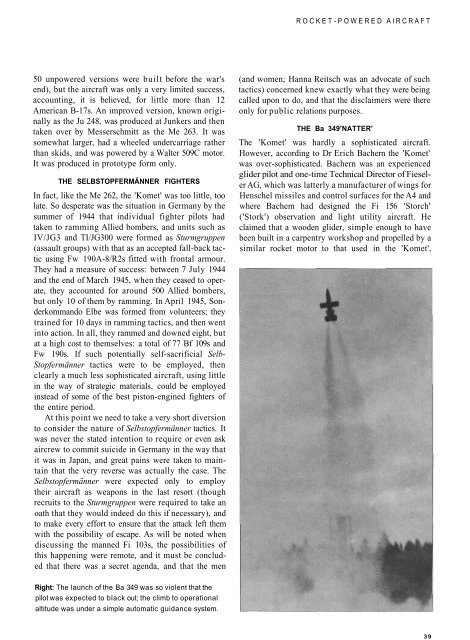Submarines and their Weapons - Aircraft of World War II
Submarines and their Weapons - Aircraft of World War II
Submarines and their Weapons - Aircraft of World War II
Create successful ePaper yourself
Turn your PDF publications into a flip-book with our unique Google optimized e-Paper software.
50 unpowered versions were built before the war's<br />
end), but the aircraft was only a very limited success,<br />
accounting, it is believed, for little more than 12<br />
American B-17s. An improved version, known originally<br />
as the Ju 248, was produced at Junkers <strong>and</strong> then<br />
taken over by Messerschmitt as the Me 263. It was<br />
somewhat larger, had a wheeled undercarriage rather<br />
than skids, <strong>and</strong> was powered by a Walter 509C motor.<br />
It was produced in prototype form only.<br />
THE SELBSTOPFERMÄNNER FIGHTERS<br />
In fact, like the Me 262, the 'Komet' was too little, too<br />
late. So desperate was the situation in Germany by the<br />
summer <strong>of</strong> 1944 that individual fighter pilots had<br />
taken to ramming Allied bombers, <strong>and</strong> units such as<br />
IV/JG3 <strong>and</strong> TI/JG300 were formed as Sturmgruppen<br />
(assault groups) with that as an accepted fall-back tactic<br />
using Fw 190A-8/R2s fitted with frontal armour.<br />
They had a measure <strong>of</strong> success: between 7 July 1944<br />
<strong>and</strong> the end <strong>of</strong> March 1945, when they ceased to operate,<br />
they accounted for around 500 Allied bombers,<br />
but only 10 <strong>of</strong> them by ramming. In April 1945, Sonderkomm<strong>and</strong>o<br />
Elbe was formed from volunteers; they<br />
trained for 10 days in ramming tactics, <strong>and</strong> then went<br />
into action. In all, they rammed <strong>and</strong> downed eight, but<br />
at a high cost to themselves: a total <strong>of</strong> 77 Bf 109s <strong>and</strong><br />
Fw 190s. If such potentially self-sacrificial Selb-<br />
Stopfermänner tactics were to be employed, then<br />
clearly a much less sophisticated aircraft, using little<br />
in the way <strong>of</strong> strategic materials, could be employed<br />
instead <strong>of</strong> some <strong>of</strong> the best piston-engined fighters <strong>of</strong><br />
the entire period.<br />
At this point we need to take a very short diversion<br />
to consider the nature <strong>of</strong> Selbstopfermänner tactics. It<br />
was never the stated intention to require or even ask<br />
aircrew to commit suicide in Germany in the way that<br />
it was in Japan, <strong>and</strong> great pains were taken to maintain<br />
that the very reverse was actually the case. The<br />
Selbstopfermänner were expected only to employ<br />
<strong>their</strong> aircraft as weapons in the last resort (though<br />
recruits to the Sturmgruppen were required to take an<br />
oath that they would indeed do this if necessary), <strong>and</strong><br />
to make every effort to ensure that the attack left them<br />
with the possibility <strong>of</strong> escape. As will be noted when<br />
discussing the manned Fi 103s, the possibilities <strong>of</strong><br />
this happening were remote, <strong>and</strong> it must be concluded<br />
that there was a secret agenda, <strong>and</strong> that the men<br />
Right: The launch <strong>of</strong> the Ba 349 was so violent that the<br />
pilot was expected to black out; the climb to operational<br />
altitude was under a simple automatic guidance system.<br />
ROCKET-POWERED AIRCRAFT<br />
(<strong>and</strong> women; Hanna Reitsch was an advocate <strong>of</strong> such<br />
tactics) concerned knew exactly what they were being<br />
called upon to do, <strong>and</strong> that the disclaimers were there<br />
only for public relations purposes.<br />
THE Ba 349'NATTER'<br />
The 'Komet' was hardly a sophisticated aircraft.<br />
However, according to Dr Erich Bachern the 'Komet'<br />
was over-sophisticated. Bachern was an experienced<br />
glider pilot <strong>and</strong> one-time Technical Director <strong>of</strong> Fieseler<br />
AG, which was latterly a manufacturer <strong>of</strong> wings for<br />
Henschel missiles <strong>and</strong> control surfaces for the A4 <strong>and</strong><br />
where Bachem had designed the Fi 156 'Storch'<br />
('Stork') observation <strong>and</strong> light utility aircraft. He<br />
claimed that a wooden glider, simple enough to have<br />
been built in a carpentry workshop <strong>and</strong> propelled by a<br />
similar rocket motor to that used in the 'Komet',<br />
39


